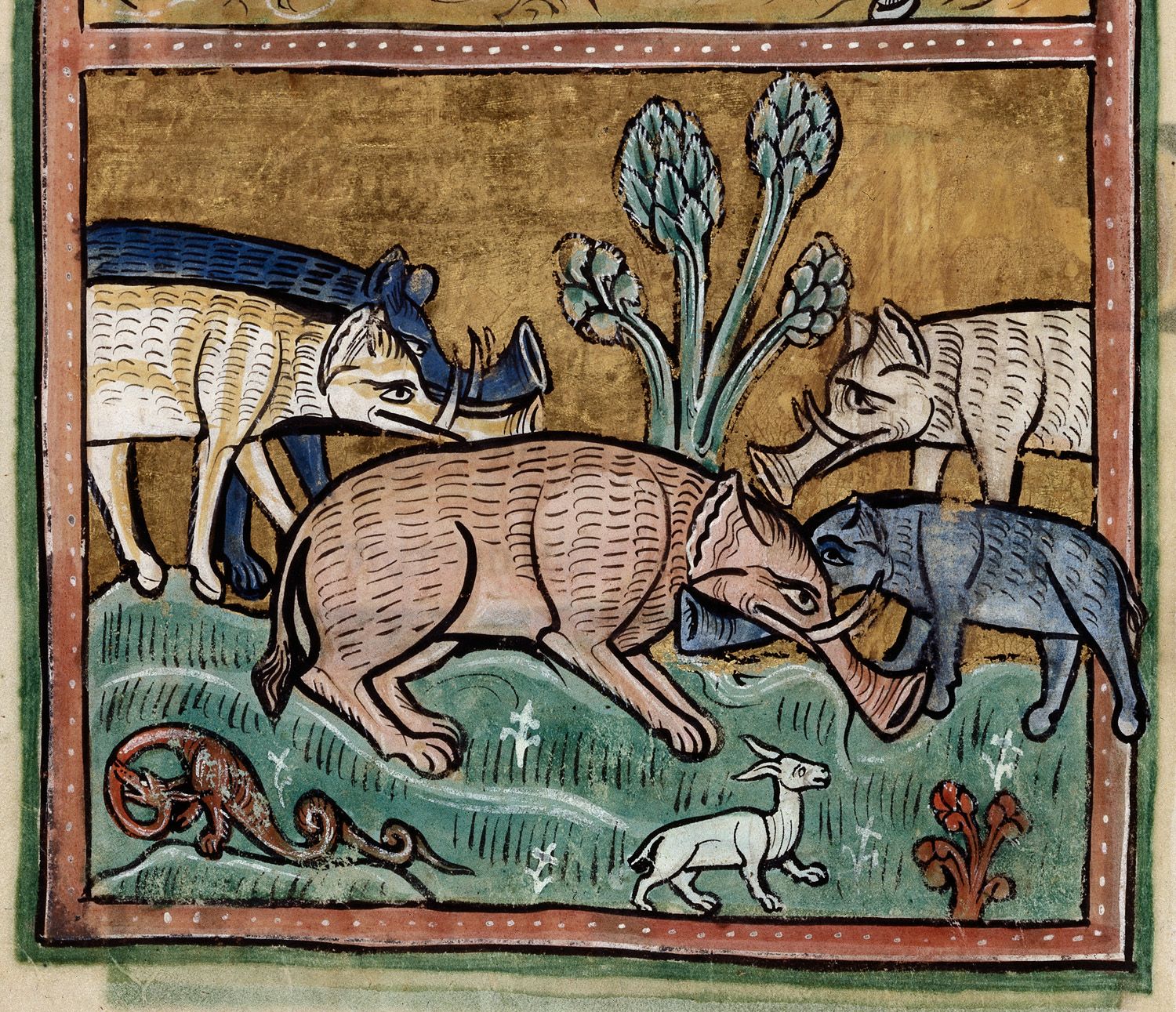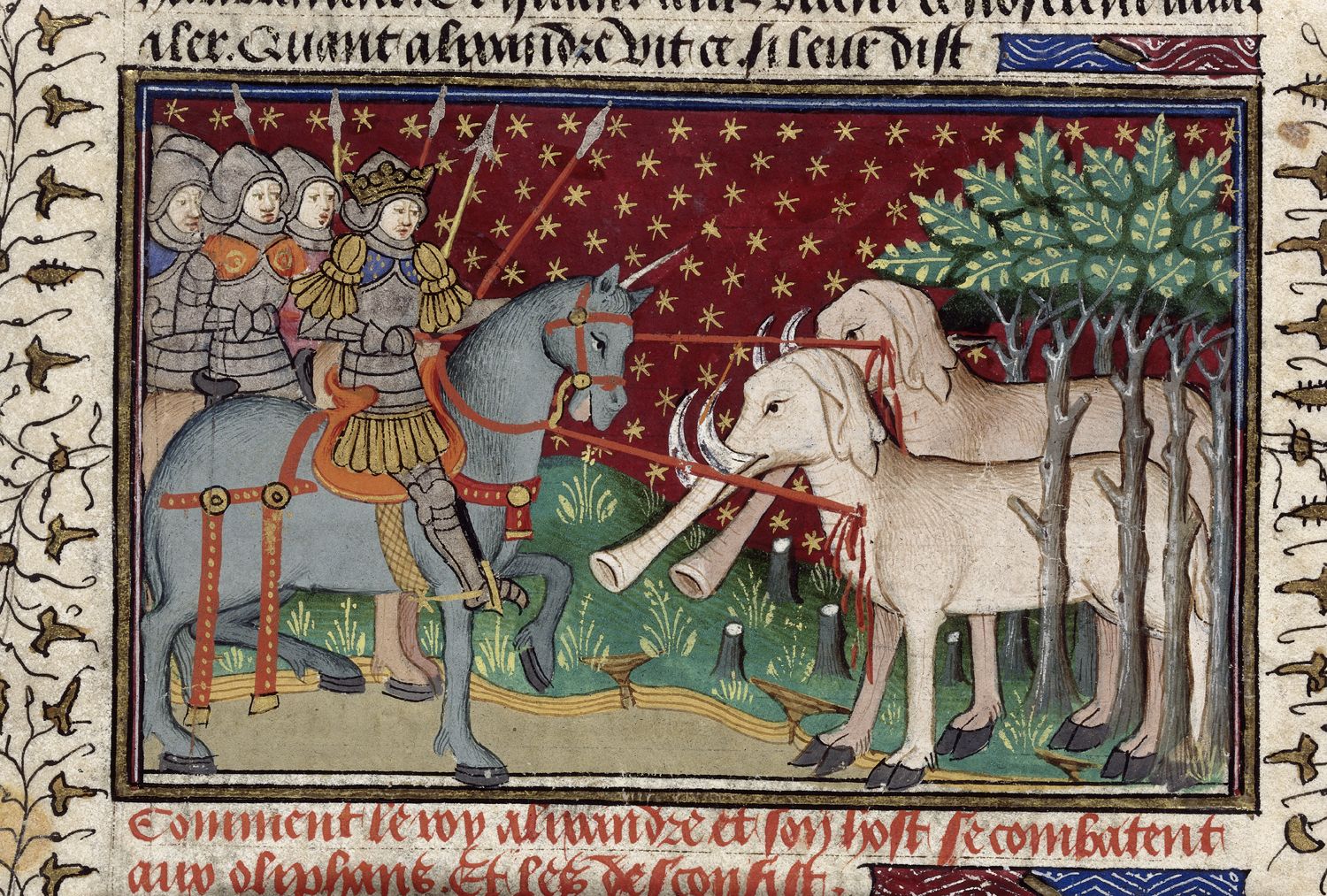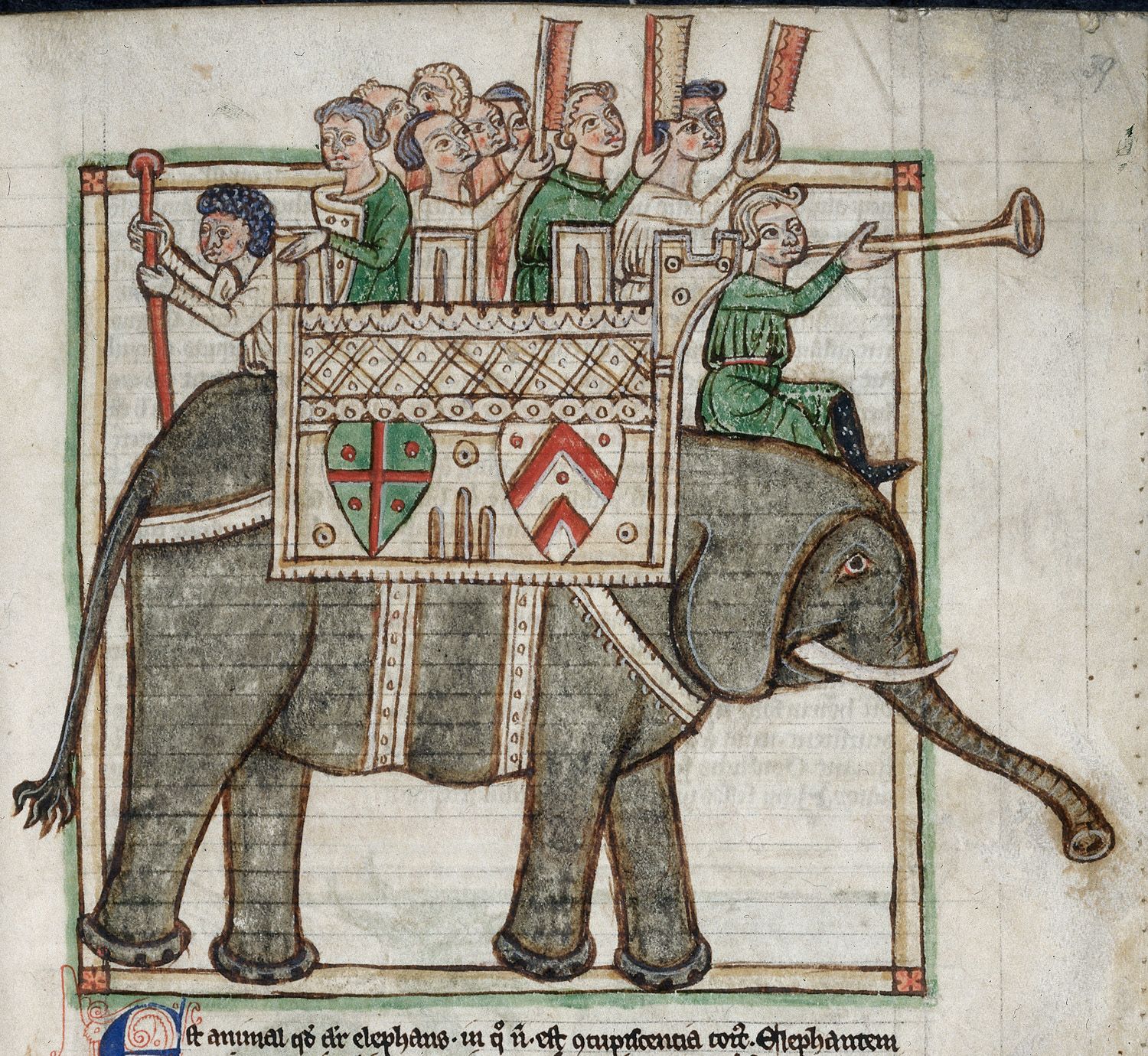Once upon a time, there was a mystical medieval animal with many extraordinary properties. Towering over the other members of the animal kingdom, this animal possessed the ability to live for 300 years. It was the sworn enemy of the dragon, and as an aid to mankind, this formidable animal frequently went to war with an entire castle on its back! As the animal did not have any joints in its legs, it was required to sleep standing up, reinforcing the idea that it was built upon never-waning pillars of strength and vitality. Our animal mated for life and produced only one offspring, a testament to its sense of honor and commitment.
At least, that’s what the medieval bestiaries will tell you.
 This image on British Library, Royal 12 F X III, f. 11v depicts five elephants. None of the elephants are shown in typical grey, and instead are portrayed as cream, tan, beige, grey blue, and dusk blue. In addition, they have very wolfish or boar-like features. This image dates from the 2nd quarter of the thirteenth century where it illustrated a bestiary written in Latin and French.
This image on British Library, Royal 12 F X III, f. 11v depicts five elephants. None of the elephants are shown in typical grey, and instead are portrayed as cream, tan, beige, grey blue, and dusk blue. In addition, they have very wolfish or boar-like features. This image dates from the 2nd quarter of the thirteenth century where it illustrated a bestiary written in Latin and French.
With all of these attributes, it is curious that men would dare to hunt these animals, yet tales of the trickery necessary for their capture abound in medieval legend. Furthermore, in extreme circumstances, the hair and bones of its venerated and innocent young could be collected and burned, the smoke creating a defense to ward off the aforementioned dragon, which seemed to be quite the problematic creature.
 BL Royal 15 E V I is also known as Poems and Romances (or the “Talbot Shrewsbury Book”), a French manuscript dated from 1444-1445. This image found on f. 16v depicts Alexander’s knights conquering two white elephants with spears.
BL Royal 15 E V I is also known as Poems and Romances (or the “Talbot Shrewsbury Book”), a French manuscript dated from 1444-1445. This image found on f. 16v depicts Alexander’s knights conquering two white elephants with spears.
What is this majestic animal, you ask? The great grey elephant of course!
 Featured in BL Harley 3244, the image on f. 39 hailed from a text by Peraldus written in Latin sometime closely after 1236. The elephant in this picture appears accurately sized and proportioned, unlike those in the other images.
Featured in BL Harley 3244, the image on f. 39 hailed from a text by Peraldus written in Latin sometime closely after 1236. The elephant in this picture appears accurately sized and proportioned, unlike those in the other images.
Also known as the Barrus and Olifant, the medieval elephant was a sight to behold. First noted in English history in 1255, an elephant was presented to King Henry III by King Louis of France. Henry of Florence became the keeper of the elephant, and it lived happily—or probably not so happily—in the Tower of London. Like many tower prisoners, the elephant unfortunately died after four years in captivity. Clearly, elephants were much more up to the task of fighting dragons and carrying around castles than being observed by the king’s curious subjects.
In actuality, elephants really were used in combat.
 Folio 11v of BL Royal 12 X III (see the companion image at the top of the post) shows a skirmish between men on an elephant and men on horseback. Unrealistically, the horses appear much larger than the elephant in this English bestiary written in Latin and French.
Folio 11v of BL Royal 12 X III (see the companion image at the top of the post) shows a skirmish between men on an elephant and men on horseback. Unrealistically, the horses appear much larger than the elephant in this English bestiary written in Latin and French.
According to the thirteenth-century British Library MS Harley 3244, elephants were once dubbed Lucanian oxen by the Romans when they met King Pyrrhus in battle in “the year of the City 472.” Persian and Indian warriors were said to construct wooden towers on the backs of these great beasts and fight with tactics normally reserved for a tower wall. As a more rational example, Aelian describes military elephants that carried “three fighting men on a cuirass, or even on [their] bare [backs], one fighting on the right, another on the left, while the third faces to the rear” (Druce).
Today, CGI fighting mûmakil, (Colloquially “oliphaunts”) appear in The Return of the King, a movie inspired by Tolkien’s work of the same name. Possibly more reminiscent of the mythical construction which could fight dragons and live up to 300 years, the Middle Earth oliphaunt is utilized by the men from the East (see Persian and Indian influence) as they engage in battle with the “good guys” of Middle Earth.
Written as a mythology for England, maybe Tolkien’s work really does ring true. If the elephants of today are merely the smaller, sweeter descendants of the Middle Earth oliphaunts, it is quite possible that the medieval bestiary’s description isn’t quite so far from the truth.
Angela Lake
MA Candidate
Department of English
University of Notre Dame
Druce, George C. “The Elephant in Medieval Legend and Art.” Archaeological Journal 76 (1919): 1-73.
This post is one of an ongoing series on Medieval Animals and their Literary Afterlives.
